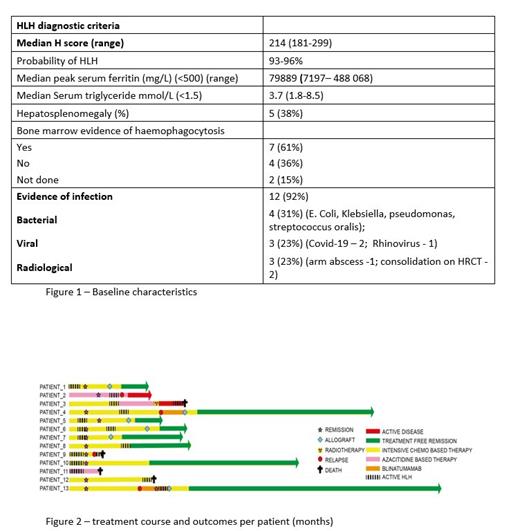Haemophagocytic lymphohistiocytosis (HLH) is a life-threatening condition in which immune hyperactivation and dysregulation results in a cytokine storm. It may be primary or secondary to infection, autoimmune disorders or malignancies (HLH-M). Lymphoma is the most widely described association in HLH-M; there is very limited data linking acute leukaemia and HLH. Current recommended treatments for HLH-M include steroids, IVIG and etoposide-containing regimens. In contrast, the recommended treatment in HLH- Macrophage activation syndrome is anti-IL1 directed therapy such as anakinra. In 2021 NHS England approved the use of anakinra to treat HLH of any cause, but the safety and efficacy data of anakinra in HLH-M is limited.
We report a retrospective review of all patients diagnosed with HLH and acute
leukaemia (AML) or acute lymphoblastic leukaemia (ALL) in a single London tertiary referral centre (University College London Hospitals NHS Foundation Trust (UCLH)), between 1 January2019 and 31 December 2022. We analysed electronic health records (EHR) of all patients diagnosed with ALL or AML and cross-referenced this with records of all patients referred to the UCLH HLH MDT. This identified 468 patients with acute leukaemia, of whom 13 (2.8%) were diagnosed with HLH. For diagnostic purposes, we utilised H scores (comprising laboratory and clinical parameters providing an HLH probability for each patient) using clinical and laboratory data collected from the EHR.
HLH was diagnosed in patients with a clinical suspicion of HLH and an H score of >169. Patients were treated with various types of immunosuppressive therapy (IST). Twelve (92%) received anakinra, three (17%) of whom had anakinra monotherapy whilst the remainder had anakinra with steroids (38%), steroids and IVIG (15%), or steroids, IVIG and etoposide (8%). Anakinra was given intravenously in eleven patients and subcutaneously in one, with a mean daily dose of 4.6mg/kg.
All patients required critical care input during their HLH treatment. Eight (62%) were admitted to intensive care unit (ICU) on diagnosis with HLH and required ventilatory and vasopressor support; the remainder were reviewed by critical care outreach. 92% patients had an initial rapid clinicopathological response following IST, becoming afebrile, reduction in oxygen requirement and haemodynamic stability seen within 24-72 hours. One patient (8%) had an initial clinical response to anakinra, methylprednisolone and IVIG triple therapy, but displayed subsequent rapid deterioration in the context of pseudomonal infection and died of multiorgan failure.
Nine patients (69%) had no clinicopathological recurrence of HLH following initial treatment. Three (23%) had an initial clinical response to IST but had subsequent biochemical and clinical relapse of HLH. These patients all had relapsed/refractory disease on HLH recurrence. Only one (8%) patient died from HLH. Eight (62%) remain in remission from leukaemia at the end of the study period. Three patients (23%) died of refractory leukaemia, whilst a fourth patient is receiving palliative care for refractory disease.
Although the link between HLH and lymphoma is well characterised, there is limited data on HLH in the context of acute leukaemia. In this case series, 2.8% of the patients treated with acute leukaemia developed HLH, which is comparable to the 3% for lymphoma quoted elsewhere. Although 92% of patients had microbiological or radiological evidence of infection on HLH diagnosis, many infections involved organisms not classically associated with HLH e.g. rhinovirus, indicating that the underlying leukaemia may play a central role in HLH-M pathogenesis. This is highlighted by the relapse of HLH which occurred alongside leukaemia relapse in three patients.
Treatment responses and outcomes were favourable compared to the existing literature. Tamamyan et al reported an overall survival rate of 15% in 13 patients with HLH-M. Delavigne et al reported a three-month mortality rate of 36% in AML patients presenting with HLH during induction, compared to our figure of 23% for this time period and our overall survival rate of 62%. We believe this is the first case series demonstrating the effectiveness and high overall survival of HLH-M patients with concurrent leukaemia diagnosis using anakinra. Early treatment with anakinra alongside other immunosuppression may explain the trend towards improved outcomes in our cohort.
Disclosures
No relevant conflicts of interest to declare.


This feature is available to Subscribers Only
Sign In or Create an Account Close Modal